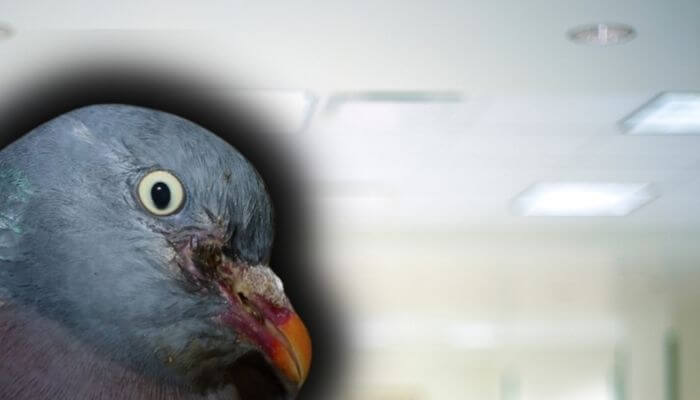Trichomonosis (also known as trichomoniasis or canker) is a disease caused by a protozoan parasite that infests the anaerobic systems of birds and mammals.
There are several different types of Trichomonas species and they differ both in terms of the symptoms they might cause but also in terms of the animals they affect.

What Types of Trichomonosis Are There?
When it comes to the types of diseases it causes, trichomonosis is different based on the exact strain.
For example, T.brixi can be found in the mouths of cats and dogs whereas T.vaginalis can be found in the reproductive or urinary system of humans and sometimes cattle.
The most common species of Trichomonosis that affect birds are:
- T.gallinae
- T.gypactinii
- T.stableri
The first is the most common one and can infect a wide range of species, although its primary victim is represented by the common chicken. However, it has been diagnosed in parrots, turkeys, and other birds.
T.gypactinii has a preference for raptors, meaning that it can most often be found in the digestive tract of eagles and hawks.
Finally, T.stableri is the most common type that can be found in the upper digestive tract of doves and pigeons.

This article was written by our qualified veterinarian Cristina.
This is part of our commitment to providing you with the most trustworthy veterinary advice for your pigeons.
Symptoms of Trichomonosis
As previously discussed, the symptoms vary depending on the exact system that the Trichomonas species tend to prefer and the animal it is found in.
However, in birds, it seems to have a preference for the digestive tract.
Consequently, most of the clinical signs that this disease causes in birds pertain to changes in digestion and discomfort and inflammation in the oral cavity, which can sometimes prevent pigeons from eating properly.
Here are a few symptoms that bird owners might notice if their flocks are suffering from trichomoniasis:
- Difficulty in swallowing
- Difficult breathing
- Confusion, disorientation
- Lethargy
- Unkempt and fluffed-up plumage
- Wet plumage around the beak
- White plaques in the trachea and crop
- Regurgitation
- Occasional green diarrhea
- Dramatic neck swelling
As previously mentioned, feeding and watering can be a challenge with these symptoms, so the birds slowly but surely become emaciated and can die in a couple of weeks’ time if they do not receive any treatment for trichomoniasis.
Causes of Trichomonosis
Trichomonas Gallinae and the other species that we have noted have a hard time surviving desiccation as parasites.
The host’s body and the drinking water are the only two places the parasite can survive.
Trichomonas infections are more common in places where pigeons need to share the same waterers and they are not disinfected on a regular basis.
The disease also appears during breeding seasons since some of the birds might regurgitate in the water and incidentally infect others.
Prognosis & Treatment
The prognosis of this disease largely depends on the health status of the birds themselves.
If the condition is allowed to progress to the point of no return, where the pigeons’ bodies are effectively incapable of fighting off the pathogen or recovering from the disease with some help, the outlook is not a positive one.
However, if the birds are seen by a vet and diagnosed as early as possible, there are some ways to treat Trichomoniasis.
The most commonly used medication for this condition is called Metronidazole and it is an antibiotic that affects anaerobic pathogens.
In case Metronidazole is not available or even seems ineffective, there are other options available, such as carnidazole or ronidazole.
These medical substances can be given to pigeons in their pill form or as a powder in the drinking water.
While both methods are effective at killing the pathogen, the second one makes it difficult for the bird owners to tell whether the patients have actually received the dosage or not.
Therefore, it is much better to opt for the individual dosage, especially in the first 3-4 days of the treatment.
Metronidazole can be used for treating Trichomonosis for a period of 2-10 days; Ronidazole needs to be given for 7 days; Carnidazole can be given in a single dose.
Species Affected By Trichomonosis
Limiting the spread of Trichomonosis in various countries is made difficult, if not impossible by the fact that it tends to affect wild birds as much as it does domesticated species.
We have already mentioned that Trichomoniasis is often diagnosed in both pigeons and doves, along with chickens and turkeys, but it is also common in the following birds:
- Chaffinch, greenfinch, goldfinch & bullfinch
- Blackbirds
- Wild ducks
- Quail
- Parrots
- House sparrows
How To Prevent The Spread Of Trichomonosis
While you do not have control over what wild birds come in your area and in contact with your own birds, you can at least practise good hygiene so that any of the pigeons or domestic birds that you own and become sick have a lower chance of transmitting the disease to the rest of the group.
Feeders and waterers need to be disinfected on a regular basis. A weak solution of commercial bleach can get the job done and is easily cheap across the world.
Make sure you thoroughly rinse out any remains of the cleaning solution, though, as bleach is dangerous for the birds’ health.
If you are planning on introducing new pigeons into your flock, quarantine them for a period of at least 7-10 days to make sure that they do not carry any type of disease.
Separate the sick birds from the apparently healthy ones. Keep an eye on the symptoms that they are continuing to exhibit and administer the treatment as per your veterinarian’s recommendations.
References:
- The antitrichomonal efficacy of garlic and metronidazole against Trichomonas gallinae infecting domestic pigeons, Sh. A. Seddiek et al, 2014: https://pubmed.ncbi.nlm.nih.gov/24488107/
- Prevalence and pathological lesion of Trichomonas gallinae in pigeons of Iran, H. Borji et al, 2011: https://pubmed.ncbi.nlm.nih.gov/23024501/
- Trichomonosis, Canadian Wildlife Health Cooperative: http://www.cwhc-rcsf.ca/docs/fact_sheets/Trich_Factsheet_EN.pdf
- Garden BirdWatch – Trichomonosis, British Trust for Ornithology: https://www.bto.org/our-science/projects/gbw/gardens-wildlife/garden-birds/disease/trichomonosis
